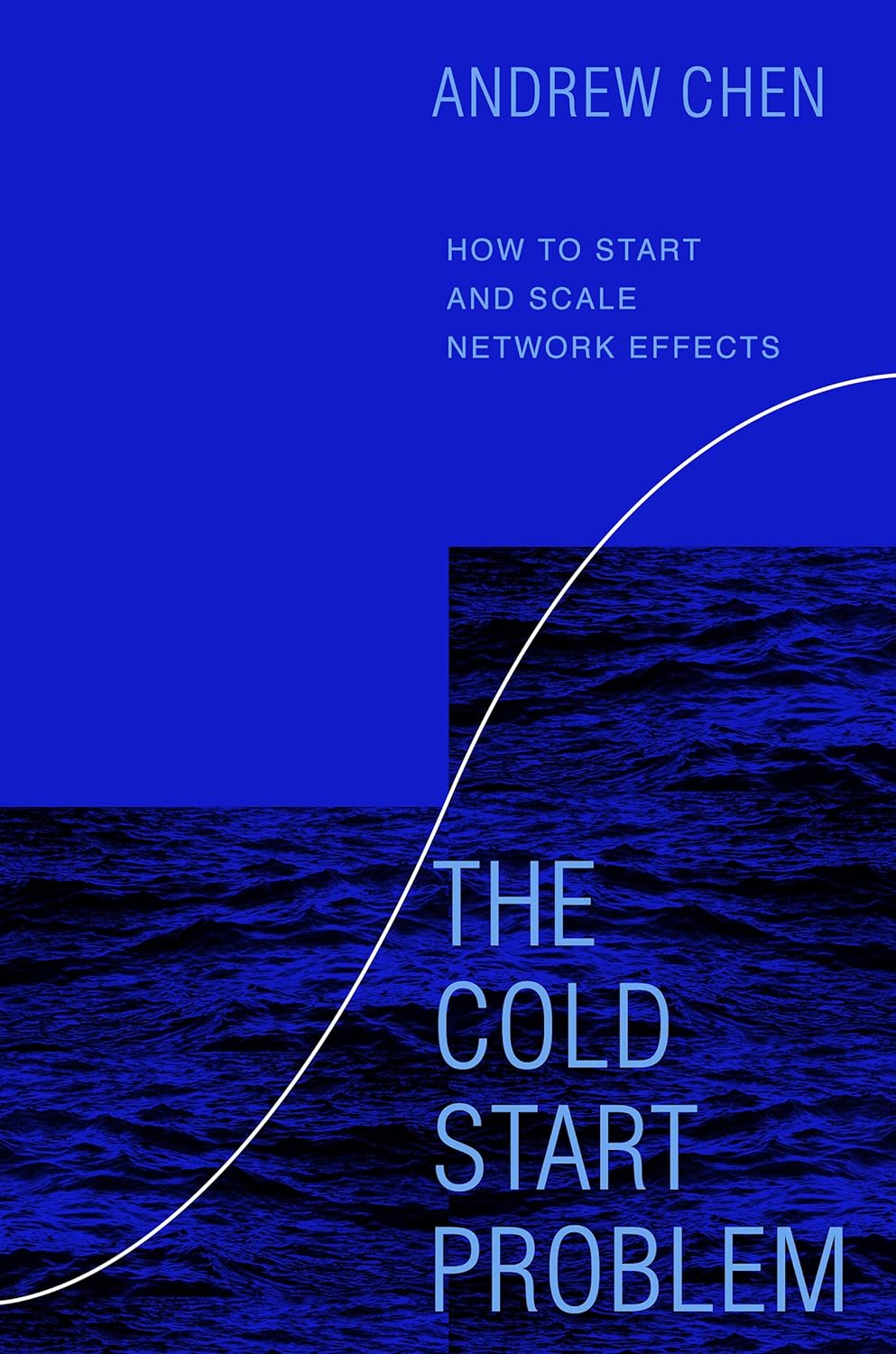
THE COLD START PROBLEM: A SUMMARY
Introduction
For a long time I’ve enjoyed Andrew Chen’s newsletter, his posts for Andreessen Horowitz (a16z) and following his comments on X (Twitter). When I heard he was publishing a book on marketplace startups and The Cold Start Problem, I was pretty pumped.
In the introduction, Andrew provides a useful (if a bit humorous) observation. Founders overuse the clichéd term “network effects” as if it were a magic pill that would assuage every V.C.’s objection. As he explains, there needs to be more depth to the idea. That depth is what he fleshes out in The Cold Start Problem.
Here is a brief summary that I hope inspires you to buy the book. Keep in mind, these notes are helpful, but nothing replaces actually reading the book.
PART I: NETWORK EFFECTS
Network based products like eBay, Slack, Facebook, Instagram, TikTok, YouTube, Reddit, and Airbnb face a challenge when launching. They aren’t valuable to users unless they already have a lot of other users on the platform. So, if you are trying to create a product like this, how do you get people to use your product when there are not already a meaningful number of other users?
A telephone without a connection at the other end of the line is not even a toy or a scientific instrument. It is one of the most useless things in the world.
- Andrew Chen Tweet
This is even more true of marketplace products, where there have to be a good number of buyers AND sellers (demand and supply) for the platform to have any value. Examples include Uber, eBay, OpenTable and AirBNB. As the ex-product growth lead for Uber, Andrew knows a thing or two about solving this problem. He calls it the “Cold Start Problem”. In the book, he explains how to overcome these problems and breaks things down into five stages. This is his Cold Start Theory:
- The cold start problem
- The tipping point
- Escape velocity
- Hitting the ceiling
- The moat
PART II: THE COLD START PROBLEM
To solve the Cold Start Problem, Andrew suggests starting with a small, specific network, called an ‘atomic network’. For instance, Facebook began at Harvard University, and Uber focused on specific locations in cities. Focus on the smallest network needed to sustain the product. This will vary greatly depending upon what your product is and Andrew provides several examples. Slack might only need 4 or 5 in-house teammates and Bank of America might need a neighborhood of 60,000. As this atomic network gets hotter, it will reach a tipping point, which is covered in the next section.
Andrew also believes in solving for the ‘hardest side’ of the network first. Network density is key here. He walks you through several examples. Tinder’s launch strategy leveraged the popularity of friends. Admittance to their parties required downloading the app. Zoom leveraged simplicity, ease of use and the ability to acquire customers through free use. This was a perfect storm to overtake apps like WebEx and Microsoft Teams. Read his case studies for further details, which include the rise of the popular social networking app Clubhouse.
PART III: THE TIPPING POINT
At first, you will have to “Flintstone” or manually create demand in a way that doesn’t scale. Or as Y Combinator’s Paul Graham would say “Do things that don’t scale.” When the network itself begins to drive growth, repeatedly, you have reached a “Tipping Point.” This is when viral growth and strong monetization happen. Great. But how do you get there?
Tinder’s success at colleges is an example. LinkedIn’s invite-only strategy targeted specific users, leading to organic network growth. Reddit initially used bots to simulate user activity, creating momentum for real user engagement. Instagram espoused a strategy of “come for the tool, stay for the network” to build their community. Andrew walks you through a chapter on couponing strategy, which helps. Then he wraps up this section reviewing methods from Uber.
At some point, scalable channels like SEO, PPC, viral growth and partnerships have to kick in. Until then, Uber employed a variety of tactics from creativity to Hustle as a System. A local celebrity might be “Rider Zero” in a new market. Special promotions were run for Uber puppies and Uber kittens (always a hit on social media, no?). Driver referral programs were key. Here Andrew quotes Lenny Rachitsky. ‘Only three sourcing strategies account for every B2B company’s very early growth. [These are: Personal network, Seek out customers where they are, Get press.] Thus, your choices are easy, yet limited.’
Only three sourcing strategies account for every B2B company’s very early growth. [These are: Personal network, Seek out customers where they are, Get press.] Thus, your choices are easy, yet limited.
- Lenny Rachitsky Tweet
As a side note, Lenny Rachitsky (ex-product growth manager at AirBNB) writes extensively about launching a marketplace business in his blog. You can see where we have referenced Lenny before in articles like “The Best Scalable Marketing Channels.” There we provide links to his series of articles on launching marketplace businesses.
PART IV: ESCAPE VELOCITY
After reaching the tipping point, products aim for Escape Velocity. This is when they scale. His growth accounting equation is:
This month’s activities = Last month’s activities + Gain or loss
You should measure CAC and average revenue per active user (ARPU).
Andrew identifies a “trio of forces” at work.
1. Engagement
This is where users tell other users to subscribe. It keeps Customer Acquisition Cost (CAC) low. Referral features really help here. You need stickiness and it is created 3 ways:
- Create new use cases
- Reinforce the core engagement “loop” of the product
- Reactivate churned users
2. Acquisition
Dense networks have higher stickiness, and a higher degree of engagement. The more types of content creators there are on the platform the more likely use cases there will be.
In this section, Andrew talks about how he learned from The PayPal Mafia. They had made viral marketing a science. These are the founders of PayPal, who later went on to create LinkedIn, Eventbrite, Tesla, YouTube, Yelp and Affirm. Some of the most influential names you’ll hear today: Elon Musk, David Sacks, Reid Hoffman, Peter Thiel and Max Levchin, to name a few.
Based on the examples of the above tech leaders, Andrew walks you through how to create viral product-driven growth.
3. Economics
The bigger your network, the more you can accelerate monetization and reduce your cost. At first, you might subsidize the hard side of the marketplace, but eventually you must choose efficiency over subsidy. That is how you will improve unit economics.
Again, density is key. Conversion rates improve as the network improves. The ability to change for premium features becomes a reality.
PART V: THE CEILING
After rapid growth, startups often reach a growth ceiling, where progress fluctuates. Andrew explains that overcoming this ceiling is an ongoing effort.
Rocketship Growth
SaaS companies that become unicorns tend to follow this path:
- Establish great Product Market Fit
- Get to $2M ARR
- Triple to $6M ARR
- Triple to $18M ARR
- Double to $36M ARR
- Double to $72M ARR
- Double to $144M ARR
The target growth rate formula looks like this:
Rocketship growth rate = ((target revenue – starting revenue) / starting revenue)^(1/years)
Saturation
Growth slows when a product dominates its market to a point that existing marketing strategies become less effective. He uses eBay as a case study.
The Law of Shitty Clickthroughs (Banner Ads)
Andrew believes that all marketing channels degrade over time. He believes you have to layer in new growth strategies. You cannot spend your way out of this shift. You must improve network effects rather than trying to spend more on marketing.
When the network revolts
Sometimes, valuable users (the ‘hard side’ of the network) demand better terms. An example would be when Uber drivers sought improved pay and benefits.
Eternal September
As a product reaches a mainstream audience, the unique qualities that made it unique to the initial community can get diluted. This will make the product less appealing and users will leave. Usenet had a bad experience with this in the month of September that seemed to never end. This audience shift has since been dubbed “Eternal September.”
Overcrowding
When a network becomes too crowded, finding relevant connections becomes difficult. Solutions might include improved search functions, algorithmic feeds, or curation tools. Startups targeting smaller customers, like Slack or Dropbox, may face higher churn rates due to their price sensitivity. Andrew suggests remaining proactive and continually adding new features and use cases.
PART VI: THE MOAT
The Moat is the stage where a network defends its position using its network effects. For networked products, their defensibility lies not in software or functionality but in the difficulty of replicating their network. His case study here was AirBNB vs. Wimdu.
Vicious cycle, virtuous cycle
Andrew references Warren Buffett’s concept of a competitive moat, focusing on the durability of a company’s advantage. Network effects create this moat.
“…it’s important to acknowledge a common myth about defensibility and moats: that somehow, network effects will magically help you fend off competition. This is a myth repeated again and again in startup pitch presentations to investors and entrepreneurs. It’s a lie that entrepreneurs tell themselves.”
…it’s important to acknowledge a common myth about defensibility and moats… It’s a lie that entrepreneurs tell themselves.
- Andrew Chen Tweet
Adrew challenges the perceived invincibility of “first mover advantage” citing the fact that startups disrupt the big guys all the time. They often unbundle parts of a product, cherry-pick the best part and make an app that addresses that specific need. Research “unbundling of Craigslist” if you want to learn more. If you have a network, so does your competition. It’s often the quality of the network that matters. The conclusion of these battles can be existential.
Earlier the book it is outlined how a network can create an ever upward feedback loop, or a “virtuous cycle.” Cold Start Theory states that a vicious cycle always grows alongside a virtuous cycle. If the network growth stalls and starts to collapse, reverse network effects can start to create a viral collapse. This is a “vicious cycle.”
As companies move through the Cold Start framework, different growth levers become available. Companies, big and small, each leverage network effects differently. Smaller companies are agile, while larger ones have established relationships and resources. Bigger companies have to ensure their maneuvers align with existing business, something he calls a “strategy tax.”
Cherry-picking
Smaller companies can focus on acquiring small networks from larger ones. Airbnb’s success over Craigslist in the shared-rooms market is an example. Another would be Snapchat hijacking Facebook’s most sticky use case: photos. Obviously, it is important to avoid platform dependance on others in order to scale.
Big bang launches to big bang failures
Large-scale launches can fail if they lack strong network foundations. Google+’s launch, despite initial sign-ups, lacked user engagement due to a poor Go-To-Market (GTM) strategy.
Compete over the hard side
In network competition, focusing on the most valuable part of the network, like Uber’s competition for drivers with Lyft and Sidecar, is crucial. Properly identifying and competing for these growth levers can be the life or death of your company. Andrew cites some example of how custom building tools to track the proper KPIs allowed Uber to know how they were doing in each market.
Bundling
Larger networks can enter new product domains by bundling services, as Microsoft did with Microsoft Office. You are competing for a network here, not just features, to lock in the hard side of the marketplace. Again, using Microsoft as an example, it doesn’t always work.
The Future
Andrew’s book offers a sober look at network dependent products for entrepreneurs. His many case studies walk you through strategies for launching, scaling, and competing at various stages of the Cold Start framework.
I feel most of the advice is useful for any startup trying to grow, regardless of network dependance. Certainly a book worth adding to your library.

The Cold Start Problem: How to Start and Scale Network Effects Hardcover – December 7, 2021
Author Bio
Benjamin Arritt

Share:
Follow Us:
Most Popular


10+ PERSONAL CRM OPTIONS REVIEWED

10 OUTSOURCED BDR SALES AGENCIES COMPARED

FRACTIONAL MARKETING: EFFICIENT BUSINESS GROWTH
Subscribe To Our Newsletter
No spam. Curated directories & articles about business, startups and templates.
MENU
Related Posts

How to Build a High-Performing Marketing Stack for CMO Success
Dive into our blog post to learn how chief marketing officers can transform from brand champions to revenue drivers and customer whisperers through a strategic

10+ PERSONAL CRM OPTIONS REVIEWED
Yes, there are “solutions,” but nothing is perfect. Here is the path of what I evaluated, what I liked, what I didn’t and why. I

10 OUTSOURCED BDR SALES AGENCIES COMPARED
I interviewed several of the top performers according to Clutch, but this was not my exclusive source. Here’s why: some smaller companies, without as much

FRACTIONAL MARKETING: EFFICIENT BUSINESS GROWTH
Fractional marketing involves hiring fractional marketers, or part-time marketing professionals. This way businesses can leverage specialized expertise while reducing the costs associated with a full-time
